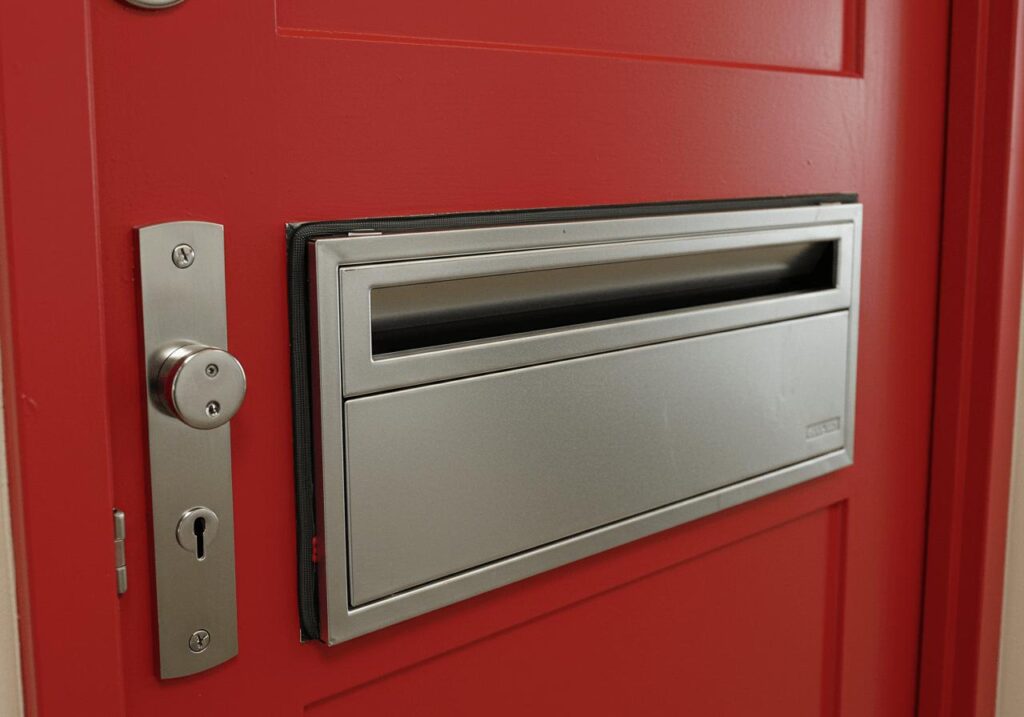Fire Doors Need Special Letterboxes: Here’s Why
Fire doors with properly installed fire-rated letterboxes play an important role in building safety by preventing the spread of fire and smoke. These specialised internal fire doors not only provide valuable evacuation time in the event of a fire but also protect lives and property when equipped with appropriate fire-resistant components like fire door accessories.
Fire doors must be fitted with specialised fire-rated letterboxes to maintain their fire resistance rating and prevent vulnerabilities. Standard letterboxes compromise a fire door’s effectiveness and create security risks, particularly in multi-occupied domestic and commercial buildings.
Key Takeaways
- Fire doors require specifically designed letterboxes that maintain the door’s fire resistance rating (typically FD30 or FD60).
- Standard letterboxes create dangerous weak points compromising fire door integrity and potential arson entry points.
- Fire-rated letterboxes contain intumescent materials that expand when exposed to heat to seal the opening.
- Regular inspection and proper fire door installation are legally required under UK fire safety regulations (like Approved Document B of the Building Regulations).
- Many fire-rated letterboxes offer additional security features and improved weather protection.
The Critical Role of Fire Doors in Building Safety
Fire doors serve as a vital component of passive fire protection. Their primary function is to prevent the spread of fire and smoke between compartments, buying time for evacuation. These specialised fire doors must meet strict fire resistance ratings, typically 30 minutes (FD30) or 60 minutes (FD60), depending on location. An FD30 fire rating means the door offers a minimum of 30 minutes of fire resistance.
Recent UK fire door regulations heighten requirements, mandating regular inspections, especially in multi-occupied residential buildings. Fire doors are designed with specialised construction: fire-resistant materials (often timber), intumescent strips (which expand), appropriate fire-rated glazing (for glazed fire doors or fire doors with glass panels), and reliable self-closing door hardware. Intumescent seals are crucial, fitted into the edges of the door or door frame.
When properly installed and maintained, fire doors form an essential part of a building’s compartmentation strategy, effectively limiting the spread of fire throughout a structure. This compartmentation is a key factor in comprehensive fire safety systems that protect both occupants and property.

Understanding the Letterbox Vulnerability
Letterbox openings can create significant weak points, compromising a fire door’s integrity. Standard letterboxes allow fire or smoke to pass through easily, reducing the fire door’s effectiveness and potentially cutting its fire resistance rating (e.g., making an FD30 fire door fail much sooner).
Beyond accidental fires, letterboxes present a security concern as targets for arson, especially in communal areas. This makes installing properly fire-rated letterboxes essential for fire safety and functionality, particularly for internal doors leading to flats.
Fire-Rated Letterboxes: Essential Features and Protection
Fire-rated letterboxes are engineered to maintain door integrity during a fire. Fitted with intumescent liners, these fire door accessories expand rapidly when hot, creating a complete seal to prevent fire and smoke from passing through the aperture.
Matching the door’s rating (e.g., FD30), they offer at least 30 minutes of fire protection. Constructed from fire-resistant materials, the key element is the intumescent material that swells to several times its original size.
Reputable manufacturers ensure their fire-rated letterboxes are tested to British Standard (e.g., BS 476 Part 22) to verify they maintain the door’s integrity for the specified period (30 or 60 minutes).
Improved Security and Additional Benefits
Many fire-rated letterboxes offer improved security features, providing additional peace of mind. Anti-fishing mechanisms prevent thieves reaching through. This dual protection is valuable in multi-unit buildings.
They can also protect mail from fire and water damage (useful with sprinkler systems).
Other benefits include:
- Telescopic designs covering door thickness.
- Weather resistance (preventing drafts).
- Various styles and finishes (complementing different styles of interior doors, like an oak fire door or a primed internal door).
- Improved energy efficiency.
Installation Requirements and Best Practices
Proper fire door installation is critical for fire-rated letterboxes. Fit using intumescent sealant to fill gaps between the door and unit. Without sealant, fire could bypass the letterbox.
Only use letterboxes tested and rated for fire doors – standard ones undermine the fire rating. Use manufacturer-supplied fixings and follow instructions. Improper installation invalidates certification. Installation should be by competent individuals familiar with fire door requirements, possibly certified by bodies like the British Woodworking Federation. Document installation for fire safety records.
Maintenance and Regular Inspection Guidelines
Regular maintenance ensures fire-rated letterboxes function properly. Inspections should verify:
- No damage to intumescent material or mechanism.
- Secure fitting.
- Flaps operate smoothly.
- Seals (including smoke seals) remain intact.
- No signs of tampering/arson.
Include letterbox inspection in the overall fire door maintenance routine required by UK fire regulations. Maintain records for compliance.
Leading Manufacturers and Product Options
Several manufacturers offer specialised fire door letterbox solutions meeting safety features and standards. Look for products offering FD30 or FD60 ratings as needed. A selection of internal fire doors for sale often includes options with pre-fitted, compliant letterboxes or recommendations for compatible fire door accessories. Consider the overall door sets for compatibility.
When selecting, look for documented compliance with relevant fire testing standards (BS 476). Retain certification documents.
Compliance with UK Fire Safety Regulations
Fire doors with letterboxes must adhere to current Building Regulations (Approved Document B) and the Fire Safety Order. Regulations are stringent, especially for multi-occupancy buildings. The 2023 UK fire door regulations emphasise regular documented inspections of all components, including letterboxes.
Fire risk assessments should address letterbox vulnerabilities, especially regarding arson risks. Failure to comply can result in penalties. Ensuring fire doors are fitted with appropriate fire-rated letterboxes and maintained correctly meets legal obligations and provides genuine safety for your home or business. Ensure that your fire door assembly provides the required minutes of fire resistance.
Sources
London Fire Brigade – Reducing arson with letterbox protection
Safelincs – Fire Rated Letter Plate System from DoorSet Global Solutions
Firestop Ltd – Intumescent Letterboxes
